Student Reflection on the 2021 Spirit-Writing and the Study of Spirit-Written Literature in Early Modern and Modern China Workshop
Huizhi Wang
University of Colorado Boulder
October 27, 2021
The “Spirit-Writing and the Study of Spirit-Written Literature in Early Modern and Modern China” was a four-session online workshop as a part of the Frogbear Summer 2021 Training Sessions. The workshop was held separately on June 1, June 3, June 8, and June 10, 2021. Six professors, Barend ter Haar (University of Hamburg), Philip Clart (Leipzig University), Katherine Alexander (University of Colorado Boulder), Marcus Bingenheimer (Temple University), Gregory Scott (The University of Manchester), and Vincent Goossaert (École Pratique des Hautes Études), shared their knowledge and research on the history of spirit-writing techniques, the range of spirit-written literature, and some collaborative tools to locate and study this literature.
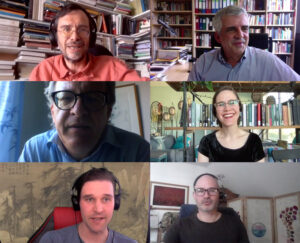
Top row: Vincent Goossaert (École Pratique des Hautes Études) and Philip Clart (Leipzig University). Second row: Barend ter Haar (University of Hamburg) and Katherine Alexander (University of Colorado Boulder). Last row: Gregory Scott (The University of Manchester) and Marcus Bingenheimer (Temple University). Screenshot courtesy of Carol Lee (UBC Frogbear). Republished with permission.
The first session on June 1 was an introduction of spirit-writing and some contemporary practices. Professor Vincent Goossaert (École Pratique des Hautes Études) first gave us a brief introduction about Daoist spirit-writing, including its definitions, different techniques, and instruments that are applied during the practice of the ritual whose pictures are shown on the slide.
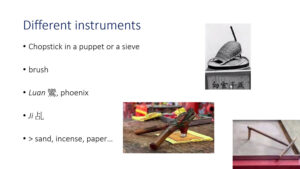
Daoist spirit-writing instruments. Slide image courtesy of Vincent Goossaert (École Pratique des Hautes Études). Republished with permission.
He also talked about the historiography of this field, explaining how scholars have studied the history of spirit-writing from different perspectives, such as learning about the history of the practice from literary sources, using ethnographic approaches, or focusing on spirit-written texts themselves in a Daoist context. Lastly, Professor Goossaert presented an overview of the history of spirit-writing, covering a time span from the medieval to the early modern period.
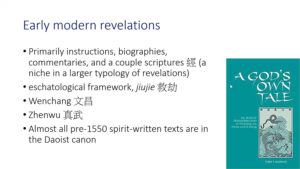
A God’s Own Tale, a literary source on Daoist spirit-writing. Slide image courtesy of Vincent Goossaert (École Pratique des Hautes Études). Republished with permission.
For the second half of the session, Professor Philip Clart (Leipzig University) gave a talk about the spirit-writing cults in Taiwan from ethnographic perspectives. Before the session, we were assigned some readings and videos as preparation, which had already provided us with a taste of some modern spirit-writing practices and his research method. During his talk, Professor Clart introduced the implements people used in the rituals, types of halls where the rituals take place, how the rituals are executed, and the objectives and functions of certain halls, among other things. All of these largely expanded our understanding of a living practice of spirit-writing in Taiwan today.
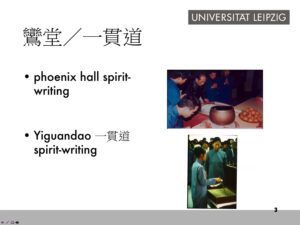

Spirit-writing ritual practices and publications in Taiwan. Slide image courtesy of Philip Clart (Leipzig University). Republished with permission.
On June 3, Professor Barend ter Haar (University of Hamburg) shared his reading on a specific text and some of its paratexts, Guan sheng di jun gan ying ming sheng jing zhu jie 關聖帝君感應明聖經註解. He first generally introduced the content of the scripture and its paratexts, such as the benefits of recitation of the text, Guan Di’s various tasks (such as overseeing morality), and its anti-Buddhist point of view. After that, Professor ter Haar stressed the significance of its prefaces as paratexts: prefaces will provide authority by virtue of their authors and the calligraphy of these authors. With a detailed reading of the prefaces, he presented his insightful analysis on the quality of the language, where and when the texts were produced, and the purpose of the prefaces. For the rest of this session, Professor Goossaert showed us a website where we can find information on those spirit-writing texts, which was also the main subject of the following two sessions, the Chinese Religious Text Authority (CRTA): https://crta.info/wiki/Main_Page. The session ended with an introduction to the collections and exemplary entries listed on the website, which are about Daoism, popular religions/sectarian traditions, and morality books.
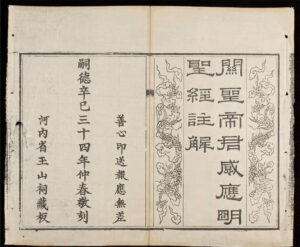
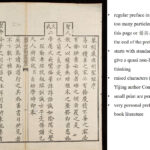
Guan sheng di jun gan ying ming sheng jing zhu jie 關聖帝君感應明聖經註解. Accessed via https://lib.nomfoundation.org/collection/1/volume/334/. Slide/photo image courtesy of Barend ter Haar (University of Hamburg). Republished with permission.
The third session on June 8 was an extensive introduction to the CRTA database given by Professors Katherine Alexander (University of Colorado Boulder), Vincent Goossaert (École Pratique des Hautes Études), and Gregory Scott (The University of Manchester). They discussed the purpose and mission of the CRTA, then showed us how we can use and contribute to it as researchers ourselves. We learned that the CRTA is a project that seeks to collect and present reliable bibliographic and scholarly information about religious texts in Chinese produced prior to 1949. It can be a starting point for scholars to discover basic information about certain texts. It is also a collaborative source, which means everyone can create and edit entries. We then learned about what the website looks like, what an entry looks like, and the type of information it includes, such as associated persons, publishers, publication dates, the main content, et cetera. Lastly, Professor Marcus Bingenheimer (Temple University) led us through the technical procedure, which was a little intimidating at first sight, especially for students in the humanities.
However, when it came to creating an entry by ourselves during the fourth session on June 10, it was actually not as impossible as it seemed. During this session, we had a hands-on training in editing CRTA entries under the guidance of all the professors. We were assigned to several breakout rooms and guided by a professor to create our own entries about a Chinese religious text.
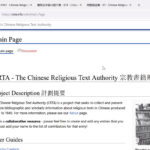
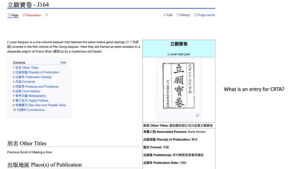
CRTA website and a religious text entry. Screenshots by Vincent Goossaert (École Pratique des Hautes Études) and Katherine Alexander (University of Colorado Boulder). Republished with permission.
To sum up, for those of us who are interested in Chinese culture, religion, and even literature, the workshop not only familiarized us with some spirit written texts and the practices of spirit writing, but also provided us with the ability to use and contribute to the CRTA database, a promising website of religious texts which will become increasingly useful during our own research in the future.
Huizhi Wang is currently an MA student at the University of Colorado Boulder. Her research interest is mainly in medieval Chinese literature and culture, especially the interaction between literature and Buddhism.







